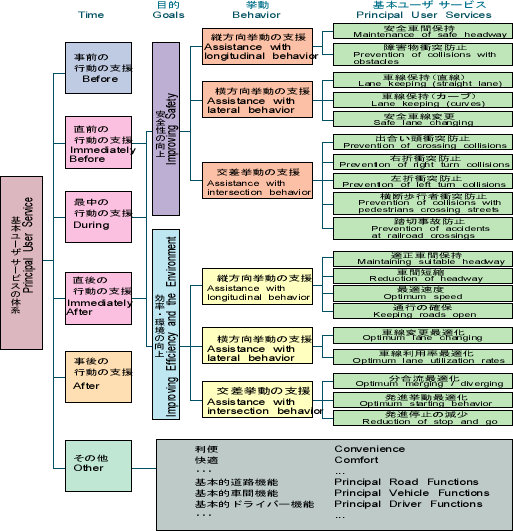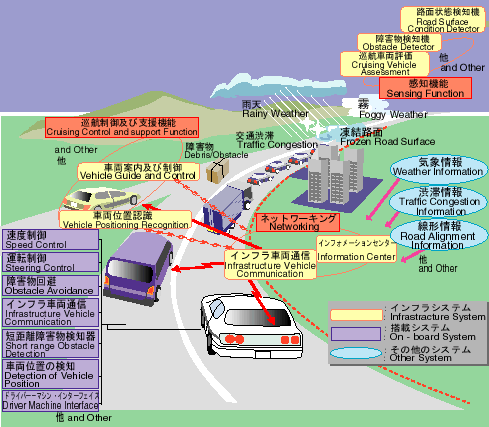
| Section 3 ITS toward Advanced Deployment |
AHS:(Advanced Cruise-Assist Highway Systems) |
-AHS(Advanced Cruise-Assist Highway Systems)
The Advanced Cruise Assist Highway System (AHS) is one of the most advanced systems in the ITS field. The goal of AHS is to reduce traffic accidents, enhance safety, improve transportation efficiency as well as reduce the operational work of drivers. A number of related effects are also expected.
In Japan, AHS research is being carried out in the following fields:

-Research and development are promoted through the joint efforts of the Ministry of Construction and the AHS Research Association.
The Ministry of Construction is promoting research and development of AHS in cooperation with the Advanced Cruise-Assist Highway System Research Association.
In September 1996, a test run took place on the part of the Joshinetsu Expressway, between Komoro IC and Tobu-Yunomaru IC which was not yet open. The test run consisted of continuous automatic driving on an 11-km-round-trip, and a safe driving system of collision prevention and lane deviation prevention.
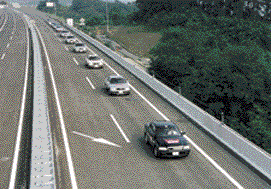 Automatic driving experiment using a group of 11 cars Automatic driving is made possible through the radar mounted on the cars and the continuously installed LCX cables along the road which send signals to indicate the speed and so forth. |
 Test run on the road yet to be open (September 1996) The LCX cables are installed on the other side of the car. |
-Advanced Safety Vehicle-ASV
The ASV (Advanced Safety Vehicle) project was launched in 1991 i order to join advanced technologies to vehicles for their greater safety. The ASV Promotion Study Group, set up jointly by the Ministry of Transport, opinion leaders and automakers, has pushed forward with the project. The first phase was completed in 1995, and the second phase has been underway since 1996.
In the second phase, the extent of research has been expanded to include trucks, buses and motorcycles, increasing the number of participating makers from 9 to 13. Two more development areas-automated driving technology and vehicle basic technology-have been added to the major safety technology field, brining the total to six areas for 32 systems.
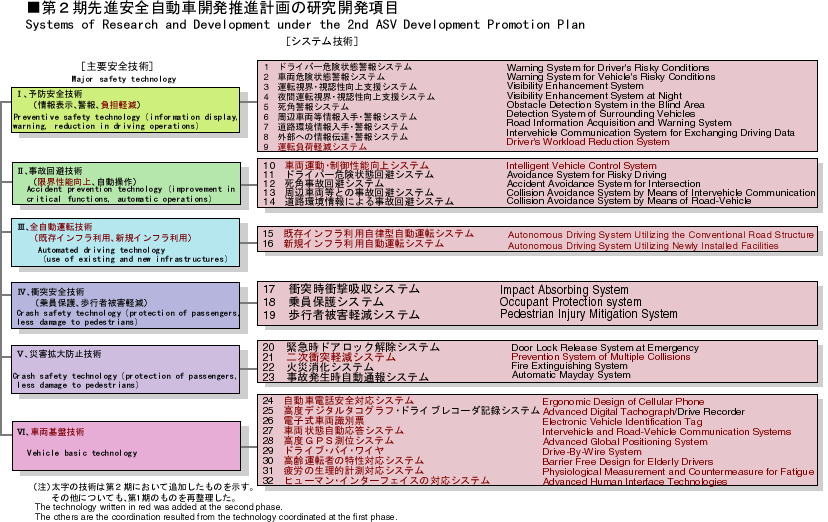
-Combination of AHS and ASV for much greater safety
In the second phase of the ASV project, research and development will be promoted in connection with infrastructures, using two systems-autonomous type and infrastructure-employed type. This will make it possible to combine ASV with AHS. A lot of progress has been made in technology development of the autonomous-type system, and some automakers have already embarked on commercial sales of the adaptive cruise control system. Technology development of safety vehicles will evolve into a cruise-assist system using infrastructures in connection with AHS. The further employment of advanced technologies in infrastructures is expected to improve safety performance of vehicles dramatically.
-AHS Research and Development History in Japan
|
1962-67:Automatically operated vehicles using guidance cables. 1974-84:Intelligent Vehicles with Machine Vision. 1989:The Ministry of Construction (MOC) begins AHS research and development. - Research into traffic accidents 1991 (June):Public-private research by the national government, including MOC and 24 private companies, in the field of the automated cruise. - The goals of research are warning against road danger ahead, position recognition of other vehicles, prevention of rear-end collisions, etc. |
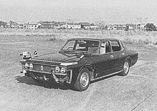 |
|
1995 (November): The world's first AHS demonstration at the Public Work Research Institute (PWRI) of MOC in Tsukuba Research Center, Ibaraki Prefecture. - The aim of the demonstration was development of vehicle control systems for longitudinal and lateral behavior. - The demonstration site was a PWRI test course of 3 km (1.9 miles). - Many visitors from Japan and abroad attended. 1996 (September):AHS demonstration at a new segment of highway before it was open to the public. - The demonstration aimed to evaluate and identify problems regarding application of AHS for use on actual highways. |
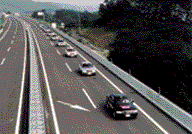 |
-Two Processes Leading to Automated Highways
We propose the following two processes to achieve fully automated highway systems.
The first (A) proposes to extend such systems to many highways and roads rather than achieving a technologically more advanced level. We call this the "Evolutionary Process".
The second (B) puts more faith in model deployments of fully automated highway systems on some segments of highways. Since technological advancement is necessary to achieve fully automated systems, we call this the "Revolutionary Process".
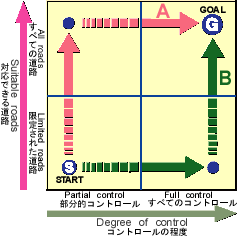
-Evolutionary Process
We classify AHS into three levels based on driving support, namely AHS-"i" (information), AHS-"c" (control) and AHS-"a" (automated cruise).
AHS-"i" supports part of the information collection for driving. AHS-"c" supports part of the driving operation as well as the information collection. AHS-"a" fully supports the driving operation and the information collection, therefore, responsibility for safe driving belongs to the AHS-"a" system.
In addition to the technological problems, we must also settle issues such as responsibility for safe driving to realize AHS-"a".
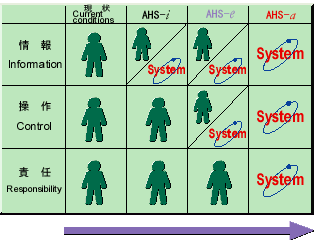
-AHS Evolution
AHS-"i" and AHS-"c" will evolve together. The level of driving support of AHS-"i" and AHS-"c" changes continuously. AHS-"a" is a fully automated system, so the responsibility for safe driving belongs to the system rather than driver. In this sense, AHS-"a" is completely different from the 99% automated AHS-"i" and AHS-"c".
We propose that AHS should follow the "evolutionary process" and that classification of AHS research into AHS-"i", AHS-"c" and AHS-"a" is important.
International system compatibility is also important in AHS research, thus international cooperation is necessary.
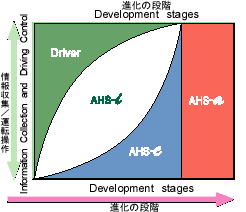
-Development of the AHS-i , c and a Concepts
|
At the San Diego Workshop in 1997, we proposed the evolutionary AHS-i, c and a concepts for AHS research. From the supplier side, we established research goals for the system components and a research process to lead to fully automated systems. No doubt, the results of research would become more useful based on the social and user demands or needs. | 
|
| Through Japanese AHS research, we will incorporate the needs-oriented demands from the user side as user services that consider the seeds-oriented view of the supplier side, create technical development guidelines or "requirements" that analysis of each user service for i, c, a levels, and engage in research that considers cost benefit analysis. | 
|
AHS - "i" (information):
system will support some of the information gathering tasks
AHS - "c" (control):
system will support some of the driving operations in addition to information gathering
AHS - "a" (automated cruise):
system will conduct 100% of the information gathering and driving operations, and to assume responsibility for safe driving
-Five Time Periods of Needs Analysis
Based upon the time period describing the aspects of an accident, we have identified five time periods that should be considered and analyzed in regard to user needs: "before", "immediately before", "during", "immediately after", and "after". We analyze these five phases of user needs independently of supply-side effects.
For example, in regard to traffic safety, vehicle safety checks and route selections based on traffic information are included in the time period "before", and the emergency response after a traffic accident is in the time period "after".
The other three time periods, "immediately before", "during" and "immediately after" are classifications of the time periods directly related to traffic incidents such as accidents and congestion. The concepts of the "during" and "after" periods include a rather long time, more than just a few seconds before and after the incidents. For example, a traffic congestion warning a mile beforehand, which relates directly to avoiding the traffic accidents, is included in the "immediately before" phase.
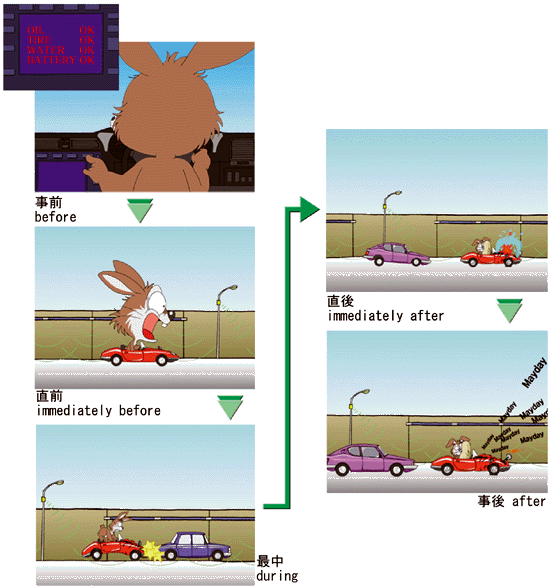
-Three Purposes for User Services
The primary purpose of AHS research is improving "safety" and "efficiency and environment ". "User services" consisting of individual services are defined after a "needs analysis" and identify the purpose for AHS research. We include personal, regional, national and international level users.
We have determined the user services through the following:
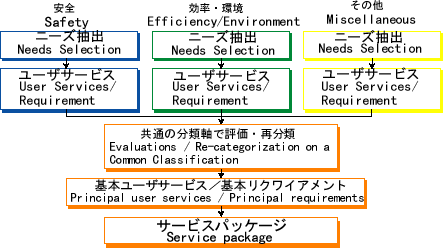
The reason for defining the principal user services and the principal requirement is to avoid confusion over principal and applied user services. In the evaluation and re-categorization process, we have defined the "principal user services" as component technologies and universal items independent of the systems, separate from the actually offered services or "service package".
The service packages are combinations of principal user services matching a given purpose with necessary additional services added. When actually applied to a society, service packages shall be determined while considering various elements in an integrated manner such as efficiency, cost, technological viability, social viability, synergetic effects with other related services, likelihood of development, etc.
| Basic Items | Application Items | |
| Meanings | Universal Items not dependent upon component technologies | Items related to provided actual services |
| User Services | Basic user services | Service package |
